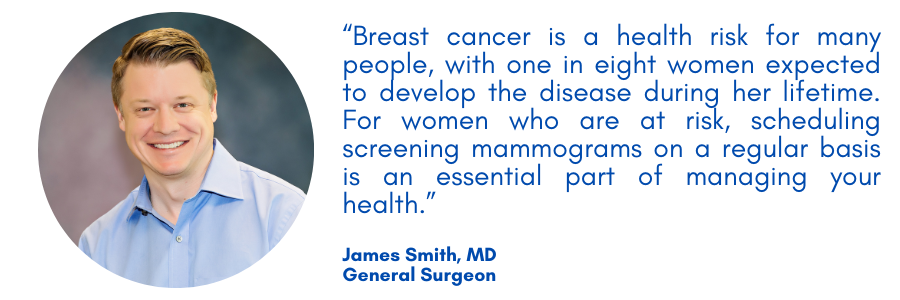October 17, 2024

October is Breast Cancer Awareness Month – a time for all of us to acknowledge the impact breast cancer can have on our lives, and to learn about the ways we can keep ourselves healthy. Breast cancer is a health risk for many people, with one in eight women expected to develop the disease during her lifetime. Thankfully, breast cancer is very treatable – if detected early. For women who are at risk, scheduling screening mammograms on a regular basis is an essential part of managing your health.
This October, add Breast Cancer Awareness Month to your calendar, and ask your provider if it’s time for your mammogram. Here’s what you need to know about this potentially life-saving screening.
What is a mammogram?
A mammogram is a low-dose x-ray of your breast, designed to spot abnormalities that may be signs of cancer. Once it reaches a later stage, breast cancer might feel like a small, hard lump in your chest, but in early stages it may feel like nothing at all. By scheduling preventive screenings, you are more likely to detect breast cancer in these early stages, when treatments are most effective.
When should I get a mammogram?
Most women should get their first mammogram at age 40. After that, you should schedule a mammogram every one to two years, depending on your age, genetic history, and other risk factors. Women who are at a higher risk of cancer should be screened each year, while women who are 55 or older may only need to get their mammogram every two years. Ask your primary care provider what screening schedule is right for you.
What happens during my mammogram?
When you arrive for your mammogram, you will undress from the waist up and change into a gown. Make sure not to wear any deodorants, lotions or perfumes on your upper body on the day of the exam, as these may interfere with the screening process.
A female technician will help you position your breasts one at a time between two plastic imaging plates. These plates will gently squeeze your breast, flattening the tissue as your technician takes x-ray pictures from multiple angles. This process will take 20 to 30 seconds. You may feel some discomfort, but it’s important to remain in this position as it allows for clearer images using less radiation.
Once your screening is complete, a radiologist will review your x-rays and send your doctor a report. If your doctor spots something unusual, they may request a second mammogram or a breast ultrasound. Remember: most suspicious findings are not cancer. It’s common to get unusual findings after your first mammogram, because your doctor does not have previous images for comparison. Often, an unusual finding is just a spot of dense tissue or the result of an unclear image.
If this is your first mammogram, don’t worry! Some women feel concerned that the screening will be painful, but today’s medical equipment is designed to make your experience as comfortable as possible. Celebrate Breast Cancer Awareness Month by scheduling your mammogram this October, and know that you’re taking an important step in managing your breast health for the years to come.

